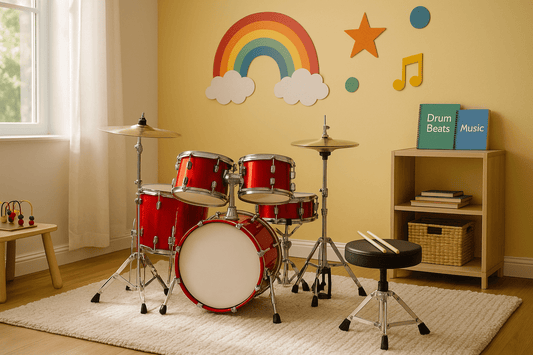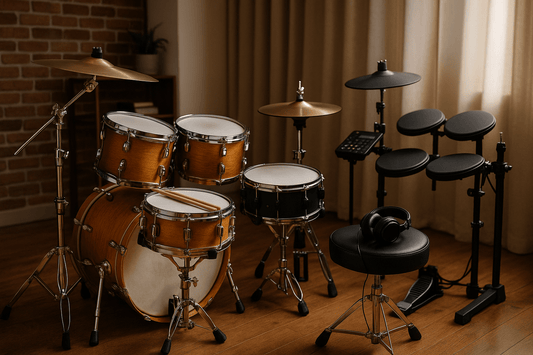Introduction
Why Acoustic Foam Matters in a Home Studio
Creating music, podcasts, or video content at home? Then you already know that great sound is everything. No matter how high-end your mic or interface is, poor acoustics can ruin a recording. Echoes, room reflections, and background noise can make your audio muddy and unprofessional.
That’s where acoustic foam panels come in.
These lightweight, easy-to-install panels help transform your room into a more controlled, sound-friendly environment. By reducing unwanted reflections and reverberations, they allow your recordings to sound crisper, cleaner, and more professional—right from your home studio.
And if you're in Australia, you're in luck. The local market now offers some of the best acoustic foam options designed specifically for home use, shipped quickly and affordably from Aussie-based stores like Tempo Gear.
What Makes a Foam Panel “The Best”?
Not all foam is created equal. The best acoustic foam panels strike a balance between:
-
Effective sound absorption (especially in mid and high frequencies)
-
Durability and shape retention
-
Easy installation and flexibility in placement
-
Stylish appearance or low-profile design
-
Good price per panel—especially in bulk packs
In this guide, we’ll explore the top acoustic foam panels available in Australia in 2025, what to look for, and how to get the most out of your setup.
What Is Acoustic Foam and How Does It Work?
Sound Absorption vs Soundproofing
Let’s clear this up right away: acoustic foam does not soundproof a room.
Instead, it absorbs sound energy, especially from mid to high frequencies like vocals, claps, and instrument tones. It prevents sound waves from bouncing off hard surfaces like walls, ceilings, and desks, which creates that dreaded echo or “boomy” sound.
So, when you install acoustic foam panels in your home studio, you’re not blocking sound from coming in or out—you’re controlling the sound inside the room, which is essential for:
-
Recording vocals or instruments
-
Mixing music with accuracy
-
Making your content more professional
Key Foam Features to Understand (Density, NRC, Design)
To choose the best foam for your home studio, you need to understand the basics:
-
Density: Higher density foam absorbs more sound, especially lower frequencies.
-
NRC (Noise Reduction Coefficient): This rating (0.0 to 1.0) tells you how well a material absorbs sound. Look for 0.4 or higher for effective home treatment.
-
Surface Design:
-
Wedges increase surface area, good for general use.
-
Pyramids scatter sound in multiple directions.
-
Egg crate foam is affordable and offers wide coverage.
-
Flat panels work well for minimalist aesthetics.
-
Bass traps go in corners and absorb low frequencies.
-
In most cases, a combination of wedge or pyramid panels with bass traps delivers the best all-around improvement.
Top Benefits of Acoustic Foam in Australian Home Studios
Clarity in Recordings and Mixes
Good acoustics allow your microphone to pick up your voice or instrument with precision—no added echo, room tone, or slapback. And when it comes time to mix your audio, you’ll hear the truth in your monitors rather than false reflections bouncing around the room.
Cleaner input = cleaner output.
Echo Reduction and Better Sound Control
One of the biggest issues in untreated home studios is flutter echo—those rapid, high-pitched echoes that make recordings sound amateur. Acoustic foam panels absorb those reflections so you can speak, sing, or play without the room interfering.
It also makes conversations, client calls, or live streaming sound tighter and more polished.
Affordable and Easy to Install
Compared to professional soundproofing or construction-based solutions, acoustic foam is a budget-friendly, DIY fix. All you need is:
-
Mounting tape or spray adhesive
-
A measuring tool and level
-
A few hours to install everything
And unlike some sound treatments, foam panels are renter-friendly, removable, and require no structural changes.
What to Look for When Choosing Acoustic Foam in Australia
Thickness and Size Options
The thickness of your foam panels plays a key role in how much sound they absorb. Here’s a quick breakdown:
-
2.5cm thick panels are suitable for basic echo control in small rooms or offices.
-
5cm thick panels (like the Tempo Gear 50x50x5cm) offer better mid-frequency absorption, making them ideal for home studios, podcasts, and video recording.
-
7.5cm+ thickness provides more absorption and better control of low-mid frequencies, especially in large rooms or untreated spaces.
Panel size also matters—larger panels cover more space, reduce installation time, and help keep visual symmetry in your room.
NRC Ratings – What They Mean
NRC, or Noise Reduction Coefficient, tells you how much sound a panel can absorb. An NRC of:
-
0.3–0.4 = light absorption (basic treatment)
-
0.5–0.7 = moderate to high absorption (ideal for most home studios)
-
0.8+ = maximum absorption (often in commercial or professional setups)
Choose panels with NRC ratings around 0.5 or higher for the best acoustic balance without over-dampening your room.
Panel Style – Wedge, Pyramid, Flat, Egg Crate, Bass Traps
Each style offers unique acoustic and aesthetic properties:
-
Wedge Panels: Provide great mid-range absorption and directional control. Popular in many studio setups.
-
Pyramid Panels: Offer multi-directional diffusion and a modern look. Effective and decorative.
-
Flat Panels: Sleek, subtle, and great for minimal design spaces. Often used with ceiling tiles.
-
Egg Crate Foam: Budget-friendly and widely used in casual recording spaces. Good for wide coverage but less aesthetic.
-
Bass Traps: Thicker, triangular foam placed in corners to reduce low-frequency build-up. Essential for music production and mixing.
A combination of wedge panels and bass traps is the sweet spot for most home studios.
Best Acoustic Foam Panels for 2025
1. Tempo Gear 50x50x5cm Sound Proof Foam (10 Pack)
Why it stands out:
This is one of the best all-around foam panel options available in Australia. It strikes a perfect balance between size, thickness, and affordability.
Highlights:
-
50x50cm dimensions for broad coverage
-
5cm thickness ideal for home studio use
-
Comes in a 10 pack—great value for beginners and pros
-
Neutral black tone to match most room styles
-
Easy to cut, mount, and reposition
Best for: Home recording, podcasting, streaming, or any creative workspace needing acoustic balance.
2. Pyramid Foam Panels – High NRC Performance
Pyramid designs scatter sound in multiple directions, reducing flutter echo and creating a more balanced acoustic space. These are especially useful in vocal booths or music production zones.
3. Acoustic Bass Traps – Corner Echo Control
Low frequencies love to build up in corners, which causes muddy mixes. Bass traps are larger, denser foam pieces that fit in corners and absorb those tricky low-end sounds.
Every serious studio should have at least 2–4 bass traps.
4. Egg Crate Panels – Budget-Friendly Option
Great for gamers, YouTubers, and casual podcasters who want better audio without breaking the bank. Not the prettiest option, but they get the job done in terms of basic sound control.
5. Decorative Panels for Stylish Home Studios
For those who want great sound without compromising on design, decorative acoustic panels offer style + function. These come in various colors, geometric cuts, and even art-style designs.
Where to Place Acoustic Foam in Your Studio
First Reflection Points, Corners, and Rear Walls
Strategic placement of acoustic foam panels is just as important as the type you use. To get the most out of your investment, focus on:
-
First Reflection Points: These are spots on the wall where sound from your speakers or voice hits first before bouncing back. Use a mirror while sitting at your desk—where you can see your speakers in the mirror is where the panel should go.
-
Corners: Especially for music studios or video editing rooms, bass frequencies tend to collect in corners. That’s where bass traps shine.
-
Rear Walls: Sound often reflects off the back wall and returns toward your ears, muddying what you hear. Treating this wall with foam improves monitoring accuracy and tightens overall sound.
Combining wall and corner coverage ensures both high- and low-frequency control, delivering a more natural, focused audio environment.
Ceiling Clouds and Desk Surrounds
Don’t forget about vertical reflections. In compact spaces or rooms with hard floors and ceilings, sound can bounce off the ceiling just as easily as walls.
Installing foam panels or ceiling clouds above your workstation can reduce that vertical echo and keep sound focused in your listening or recording zone.
And if you record vocals or acoustic instruments, adding foam near or behind your mic setup (like desk surrounds or mic shields) helps capture cleaner sound from the source.
Installation Tips for Home Users
Adhesive Spray vs Velcro vs Mounting Tape
There’s no “one-size-fits-all” installation method—it really depends on your wall type, room layout, and whether you’re renting or owning.
-
Adhesive Spray:
-
Pros: Fast, strong hold
-
Cons: Can damage walls or paint
-
Best for: Permanent setups
-
-
Mounting Tape or Command Strips:
-
Pros: Easy, clean removal
-
Cons: Might not stick well to foam without backing
-
Best for: Renters or light panels
-
-
Velcro Strips:
-
Pros: Reusable, repositionable
-
Cons: Requires good surface prep
-
Best for: Flexible or modular studio setups
-
Always test a small area first—especially if wall aesthetics are a concern.
How to Get Even Panel Placement
Even placement not only looks better—it helps your acoustic coverage stay balanced. Here’s how to do it:
-
Use a tape measure to plan spacing and alignment
-
Mark panel outlines lightly with a pencil or chalk
-
Use a level to keep rows straight, especially for grid layouts
-
Begin from the center of your target wall and work outward symmetrically for a clean look
Installing panels is a one-time job, but it pays off every time you hit record or playback.
Why Tempo Gear Acoustic Foam Stands Out in Australia
Australian-Owned, Local Shipping, Proven Quality
Tempo Gear isn’t just another online store—they’re based in Australia, meaning you get:
-
Faster delivery
-
No import hassles
-
Local support if you need help
Their foam products, like the 50x50x5cm Sound Proof Foam (10 Pack), are built with Aussie homes and studios in mind—providing excellent acoustic treatment for local conditions, room sizes, and studio setups.
Great Value Packs and Studio-Ready Options
Tempo Gear’s offerings are ideal whether you’re just starting out or expanding your sound-treated space. Their bundle packs give you the flexibility to cover multiple walls or build your treatment in stages.
Need to treat a full room? Buy in multi-packs.
Only have a small vocal corner? Start with one pack and build up.
Either way, their foam is easy to cut, shape, and install—and looks just as clean as it sounds.
FAQs About Buying Acoustic Foam in Australia
Q1: Is acoustic foam the same as soundproofing foam?
No. Acoustic foam absorbs sound reflections inside a room to improve clarity, while soundproofing foam blocks sound from entering or exiting. For home studios, acoustic foam is best for reducing echo and improving sound quality, not for blocking outside noise.
Q2: How many panels do I need for a small studio room?
A good starting point is to cover 20–30% of your total wall space. For a standard 3x3m room, that usually means 8 to 12 panels. Tempo Gear’s 10-pack is a great starter set.
Q3: Where can I buy acoustic foam panels in Australia?
For local shipping, high-quality materials, and trusted customer support, check out Australian-based providers like Tempo Gear, which offers a full range of acoustic foam styles, sizes, and packs for studios and workspaces.
Q4: Can I paint or customise acoustic foam?
Technically yes, but it’s not recommended. Painting can block the open-cell structure, reducing effectiveness. If aesthetics matter, consider decorative acoustic panels or using foam covers.
Q5: Will acoustic foam work on ceilings or concrete walls?
Absolutely! You’ll just need the right adhesive. For concrete or textured surfaces, use strong spray adhesive or glue. For ceilings, secure placement with extra adhesive or mounting strips rated for overhead use.
Conclusion: Get Pro-Level Sound at Home
Acoustic foam panels are one of the easiest, most affordable upgrades you can make to a home studio. Whether you’re a musician, content creator, gamer, or podcast producer, quality foam will instantly improve your sound environment—from recording to playback.
With Australian-made solutions like the Tempo Gear Sound Proof Foam (10 Pack), you get a powerful mix of performance, durability, and value—shipped quickly and ready to install.
So if you're ready to treat your space, skip the guesswork and start with the best acoustic foam Australia has to offer.
Explore the full collection of home studio solutions at Tempo Gear and experience the sound difference for yourself.




